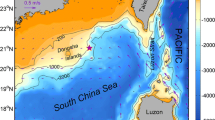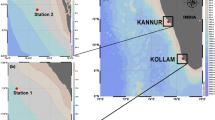Abstract
To observe vertical structure and temporal variations of currents in the Tsushima Warm Current region of the Korea Strait, a moored buoy system was deployed in autumn 2009. The moored buoy system measured vertical profiles of current, temperature, and salinity for 24 days and a background hydrographic survey was performed. Along-strait northeastward currents were dominant in the upper layer (8–35 m). The mean current veers counterclockwise from 48 m to 74 m as much as 50°, and its speed is reduced with depth. There were distinct northward onshore currents near the bottom (65–80 m). It was demonstrated that thermal wind relation holds in the inclined pycnocline layer, which generates the counterclockwise veering current structure. Density gradient along the strait is a main factor producing the cross-strait onshore current component below the upper-layer and the cross-strait density gradient reduces the along-strait current component with depth. Previous studies have never focused on the effect of the along-strait density structure on current structure. The first Empirical Orthogonal Function mode (CM1) of current variability explains 70% of local current variations and its vertical structure is close to the mean current structure. The correlation analysis among variations of CM1 current, slope of sea level anomaly (SSLA) and local wind anomaly revealed that the variation of CM1 current is mainly related to the variation of SSLA across the strait (c-SSLA), which is known to be controlled by remote and local wind forcing. Similarity between vertical structures of mean and CM1 current suggests that thermal wind relation is the main dynamics maintaining the counterclockwise turning of CM1 current below the upper layer although the upperlayer CM1 current is controlled by c-SSLA through barotropic geostrophic relation. Time series of temperature and salinity indicate that the thermohaline front between Korean Coastal Water and Tsushima Warm Current Water meanders in time and migrates over the mooring station back and forth. The front meandering and migration also affect the local SSLA and CM1 current variations in autumn in the Korea Strait.
Similar content being viewed by others
References
Beckenbach E, Terrill E (2008) Internal tides over abrupt topography in the Southern California Bight: observations of diurnal waves poleward of the critical latitude. J Geophys Res 113:C02001. doi: 10.1029/2006JC003905
Bowden KF (1983) Physical oceanography of coastal waters. Ellis Horwood, Chichester, UK, 302 p
Chereskin TK (1995) Direct evidence for an Ekman balance in the California Current. J Geophys Res 100(C9):18261–18269
Cho CB, Nam SH, Chang K-I (2014) Subtidal variability of the stratified shelf water off the mid-east coast of Korea. Cont Shelf Res 75:41–53
Cho YK, Seo GH, Kim CS, Choi B-J, Shaha DC (2013) Role of wind stress in causing maximum transport through the Korea Strait in autumn. J Marine Syst 115–116:33–39. doi: 10.1016/j.jmarsys.2013.02.002
Fukudome K-I, Yoon J-H, Ostrovskii A, Takikawa T, Han I-S (2010) Seasonal volume transport variation in the Tsushima Warm Current through the Tsushima Straits from 10 years of ADCP observations. J Oceanogr 66:539–551
Isobe A (1994) Seasonal variability of the barotropic and baroclinic motion in the Tsushima-Korea Strait. J Oceanogr 50:223–238
Isobe A, Tawara S, Kaneko A, Kawano M (1994) Seasonal variability in the Tsushima Warm Current, Tsushima-KoreaStrait. Cont Shelf Res 14:23–35
Jacobs GA, Perkins HT, Teague WJ, Hogan PJ (2001) Summer transport through the Korea–Tsushima Strait. J Geophys Res 106:6917–6929
Jacobs GA, Ko DS, Ngodock H, Preller RH, Riedlinger SK (2005) Synoptic forcing of the Korea Strait transport. Deep-Sea Res Pt II 52:1490–1504
Kang B, Hirose N, Fukudome K (2014) Transport variability in the Korea/Tsushima Strait: characteristics and relationship to synoptic atmospheric forcing. Cont Shelf Res 81:55–66. doi: 10.1016/j.csr.2014.03.010
Kim K, Lyu SJ, Kim Y-G, Choi BH, Taira K, Perkins HT, Teague WJ, Book JW (2004a) Monitoring volume transport through measurement of cable voltage across the Korea Strait. J Atmos Ocean Technol 21(4):671–682.
Kim Y-J, Takikawa T, An H-S, Yoon J-H (2004b) The seasonal and interannual variability of the volume transport through the western channel of the Korea Strait. J Korean Soc Oceanogr 39:155–162
Kundu PK (1976) Ekman veering observed near the ocean bottom. J Phys Oceanogr 6:238–242
Lee JC, Na JY, Chang SD (1984) Thermohaline structure of the shelf front in the Korea Strait in early winter. J Korean Soc Oceanogr 19:56–67
Lee JH, Chung JY (1982) A continental shelf waves off the eastern coast of Korea. La Mer 20:169–180
Lee J H, Lozovatsky I, Jang ST, Jang CJ, Hong AS, Fernando HJS (2006) Episodes of nonlinear internal waves in the northern East China Sea. Geophys Res Lett 33(18):L18601. doi: 10.1029/2006GL027136
Lyu SJ, Kim K, Perkins HT (2002) Atmospheric pressure-forced subinertial variations in the transport through the Korea Strait. Geophys Res Lett 29(9):1294. doi: 10.1029/2001GL014366
Lyu SJ, Kim K (2003) Absolute transport from the sea level difference across the Korea Strait. Geophys Res Lett 30(6):1285. doi: 10.1029/2002GL016233
Lyu SJ, Kim K (2005) Subinertial to interannual transport variations in the Korea Strait and their possible mechanisms. J Geophys Res 110:C12016. doi: 10.1029/2004JC002651
Moon J-H, Hirose N, Yoon J-H, Pang I-C (2009) Effect of the along-strait wind on the volume transport through the Tsushima/Korea Strait in september. J Oceanogr 65:17–29
Nam SH, Lyu SJ, Kim YH, Kim K, Park J-H, Watts DR (2004) Correction of TOPEX/POSEIDON altimeter data for nonisostatic sea level response to atmospheric pressure in the Japan/East Sea. Geophys Res Lett 31:L02304
Nam S, Send U (2011) Direct evidence of deep-water intrusions onto the continental shelf via surging internal tides. J Geophys Res 116:C05004. doi: 10.1029/2010JC006692
Nam S, Send U (2013) Resonant diurnal oscillations and mean alongshore flows driven by sea/land breeze forcing in the coastal Southern California Bight. J Phys Oceanogr 43:616–630. doi: 10.1175/JPO-D-11-0148.1
Nof D (1993) The penetration of Kuroshio water into the Sea of Japan. J Phys Oceanogr 23:797–807
Nof D (2000) Why much of the Atlantic circulation enters the Caribbean Sea and very little of the Pacific circulation enters the Sea of Japan. Prog Oceanogr 45:39–67
Ohshima KI (1994) The flow system in the Japan Sea caused by a sea-level difference through shallow straits. J Geophys Res 99:9925–9940
Pedlosky J (1983) Geophysical fluid dynamics. Springer, New York, 710 p
Pineda J (1995) An internal tidal bore regime at nearshore stations along western USA: predictable upwelling within the lunar cycle. Cont Shelf Res 15:1023–1041
Rikiishi K, Ichiye T (1986) Tidal fluctuation of the surface currents of the Kuroshio in the East China Sea. Prog Oceanogr 17:193–214
Smith SR, Jacobs GA, Laben RR (2005) Determining the applicability of the barotropic approximation to the mean seasonal flow through the Tsushima/Korean Strait using variational assimilation. Deep-Sea Res Pt II 52(11):1763–1783. doi: 10.1016/j.dsr2.2004.12.025
Son YT, Lee SH, Choi BJ, Lee JC (2010) Frontal structure and thermohaline intrusions in the South Sea of Korea from observed data and a relocation method. J Geophys Res 115:C02011. doi:10.1029/2009JC005266
Takikawa T, Yoon J-H (2005) Volume transport through the Tsushima Straits estimated from sea level difference. J Oceanogr 61:699–708
Taylor JR, Sarkar S (2008) Stratification effects in a bottom Ekman layer. J Phys Oceanogr 38:2535–2555. doi: 10.1175/2008JPO3942.1
Teague WJ, Jacobs GA, Perkins HT, Book JW (2002) Lowfrequency current observations in the Korea/Tsushima Strait. J Phys Oceanogr 32:1621–1641
Thompson RORY (1983) Low-pass filters to suppress inertial and tidal frequencies. J Phys Oceanogr 13:1077–1083
Weatherly G, Martin P (1978) On the structure and dynamics of the oceanic bottom boundary layer. J Phys Oceanogr 8:557–570
Yang YJ, Kim SH, Rho HK (1998) A study on the temperature fronts observed in the south-west sea of Korea and the northern area of the East China Sea J Korean Fish Soc 31:695–706 (in Korean)
Yi SU (1966) Seasonal and secular variations of the water volume transport across the Korea Strait. J Oceanol Soc Korea 1:7–13
Yi SU (1970) Variations of oceanic condition and mean sea level in the Korea Strait. In: Marr JC (ed) The Kuroshio: a symposium on the Japan Current. East-West Center Press, pp 125–141
Yoshikawa Y, Matsuno T, Marubayashi K, Fukudome K (2007) A surface velocity spiral observed with ADCP and HF radar in the Tsushima Strait. J Geophys Res 112:C06022. doi: 10.1029/2006JC003625,2007
Author information
Authors and Affiliations
Corresponding author
Rights and permissions
About this article
Cite this article
Lee, SH., Choi, BJ. Vertical structure and variation of currents observed in autumn in the Korea Strait. Ocean Sci. J. 50, 163–182 (2015). https://doi.org/10.1007/s12601-015-0013-5
Received:
Revised:
Accepted:
Published:
Issue Date:
DOI: https://doi.org/10.1007/s12601-015-0013-5




